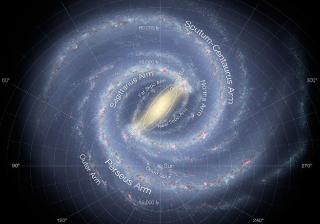Bibcode
Wang, Hai-Feng; Carlin, Jeffrey L.; Huang, Y.; López-Corredoira, Martíin; Chen, B. -Q.; Wang, C.; Chang, J.; Zhang, H. -W.; Xiang, M. -S.; Yuan, H. -B.; Sun, W. -X.; Li, X. -Y.; Yang, Y.; Deng, L. -C.
Referencia bibliográfica
The Astrophysical Journal
Fecha de publicación:
10
2019
Revista
Número de citas
23
Número de citas referidas
21
Descripción
We investigate the three-dimensional asymmetrical kinematics and present time stamps of the Milky Way disk between Galactocentric distances of R = 12 and 15 kpc, using red clump stars selected from the LAMOST Galactic survey, also with proper motion measurements provided by the Gaia DR2. We discover velocity substructure above the Galactic plane corresponding to a density dip found recently (“South-middle opposite” density structure [R ̃ 12-15 kpc, Z ̃ 1.5 kpc] discovered in Wang et al.) in the radial and azimuthal velocity. For the vertical velocity, we detect clear vertical bulk motions or bending mode motions, which has no clear North-South asymmetry corresponding to the in-plane asymmetrical features. In the subsample of stars with different ages, we find that there is little temporal evolution of the in-plane asymmetry from 0 to 14 Gyr, which means the structure is possibly sensitive to the perturbations in almost cosmic time. We propose that the possible scenario of this asymmetric velocity structure is caused by the mechanisms generated in-plane, rather than vertical perturbations.
Proyectos relacionados

Morfología y dinámica de la Vía Láctea
El Proyecto se estructura en dos partes, diferenciadas pero complementarias: morfología y dinámica. El estudio detallado de la morfología de la Vía Láctea pretende proveer una base de datos de distribución estelar en las regiones más alejadas y extintas de nuestra Galaxia, mediante el desarrollo de modelos semiempíricos a partir de la información
Martín
López Corredoira